Close friendships are wonderful, allowing us to form deep connections with a select few people who act as our core support system. But we shouldn’t underestimate the friends and professional ties outside our inner circle, either. A recent New York Times piece made a great case for cultivating casual, low-stakes friendships. Research has shown that not only can these “weak ties” boost our job prospects, but they also improve our well-being by making us more empathetic, broadening our worldview, and helping us feel more connected.
We asked our Thrive community for their best tips for maintaining their “weak ties” relationships. Here are some of our favorites:
Ask the right questions and follow up
“I focus on cultivating relationships from the moment I first meet someone new. One of the questions I ask people is, ‘What are you most excited about right now?’ By asking this question, it invites people to share what lights them up or what they are passionate about. I make a mental note of that and it guides any follow up I have with them, even if the thing they are most passionate about is not their job. I have a reminder in my calendar to follow up with people about every three weeks and I send a thoughtful message, email or text that pulls from those things that person is passionate about just to let them know I was thinking of them. For example, sending a thank you card with a picture of a dog on it to someone who loves dogs leaves a lasting impression. You don’t have to follow up as often when you know how to send meaningful and memorable messages.”
—Tara Bradford, publicity strategist, New York City
Use social media
“With social media, there’s really no excuse for not staying in touch with people! Instagram, in particular, has helped me connect with many old friends I haven’t seen in years and whose numbers I don’t have. Small interactions — liking their posts, dropping a nice comment, sending a reaction to their status updates — can spark conversations and help rekindle old ties. Even if you don’t end up chatting, at least they know you remember them and wish them well. And in the long run, that’s what counts!”
—Deya Bhattacharya, freelance writer, India
Send snail-mail birthday cards
“I have lived in numerous places throughout the years and am blessed to have friends dispersed throughout the world. One practice I have found effective is trying to send birthday cards. Nobody seems to get these anymore and therefore are highly valued. It takes effort but is definitely worth it!”
—Tricia Wolanin Psy.D., clinical psychologist and author, Mildenhall, U.K.
Use your calendar to schedule — and keep track of — social time
“In my house, the rule is: ‘If it’s not on my calendar, it doesn’t exist.’ My calendar lets me know when I need to be more social. It’s really easy to get busy with life and wonder, ‘When was the last time I saw James?’ Check the calendar. If it’s been a while, I know I need to shoot James a text and schedule dinner. If I notice that nothing social is on my calendar for the next couple of weeks, I know I need to get scheduling! When we put it on the calendar, we gain visibility into how social we’re actually being, not how social we think we’re being.
—Jeff Callahan, social confidence coach, Little Rock, AR
Send them updates on topics they’re interested in
“When I see something that will appeal to my ‘casual relationships,’ I send it with a brief note. I know one man who loves his RV and when I see the newest, coolest RV out there, I share an article about it with him. Another woman I know is active in solving homelessness. I send her articles about unusual solutions including tiny homes, retired cruise ships, and an old bus converted into a hygiene station.”
—Arielle Ford, love & relationship author/expert, La Jolla, CA
Put the effort in
“My rule for how to get the most from a relationship: ‘Whatever I want from a relationship, give more.’”
—Joshua Spodek, Ph.D., author, New York, NY
Set calendar reminders to check in with people
“I treasure so many people who have touched my life in so many ways over the years, and I try to stay in some sort of touch with them. I have birthdays noted on my calendar. I use ‘tasks’ in Salesforce (which I use for work) to remind me to reach out to friends with whom I haven’t connected in a while. And every now and then, I ask myself ‘whom have I not spoken with recently?’ and I’ll either shoot them a text or try to schedule a get-together or a chat.”
—Lisa Kohn, executive coach and author, Wayne, PA
Understand the ebb and flow of relationships
“For business ‘weak ties,’ I try and reach out to some of them if we are going to the same conference or I am visiting their area. I do my best to be connected to them via LinkedIn and post regularly. For personal looser ties, I invite them to events I’m attending, send them congratulations and birthday greetings, and stay in contact through social media. Over the years, some of those contacts have become either business partners or good friends. Others I’ve been close to are now more of a weaker tie. It is an ebb and flow, but I know the benefits of staying connected has been a gift both personally and professionally over the years.”
—Mim Senft, founder, CEO, Blooming Grove, NY
Follow us here and subscribe here for all the latest news on how you can keep Thriving.
Stay up to date or catch-up on all our podcasts with Arianna Huffington here.


